Disruptive Technologies that Changed the Course of
RCA's "Radio Central"
By John F. Schneider, 2022
|
|
Disruptive Technologies that Changed the Course of By John F. Schneider, 2022
|
|
www.theradiohistorian.org Copyright 2022 - John F. Schneider & Associates, LLC (Click on photos to enlarge) A postcard view of RCA Radio Central at Rocky Point. A view of
the energy power station at RCA Radio Central. Power for the Rocky Point facility was provided by the Long
Island Lighting Company: 23,000 volts, three phase 60 cycle current to a
substation on the property. (Library of Congress) 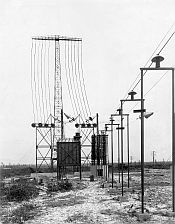 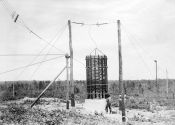 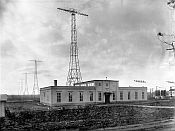 Duplicate station built by RCA at Grimeton, Sweden. (Author’s collection) 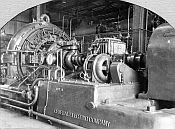 One of two alternators installed at Grimeton. (Author’s collection) 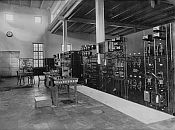 The power control panel at Grimeton. (Author’s collection) 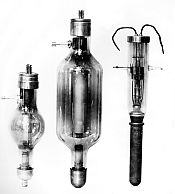 General Electric power vacuum tubes available in 1924: UV-206. 1 kW(left); UV-208, 5 kW(center); UV-207, 20 kW water-cooled tube (right). (Museum of Science and Innovation photo) 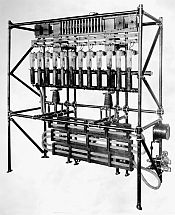 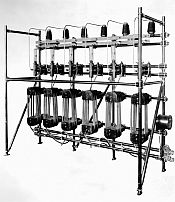 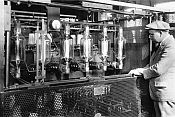
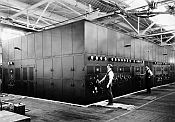
|
|
It was the
world’s largest radio station. It was
said in 1922 that RCA’s “Radio Central” at Rocky Point, Long Island, NY, was
the only station that could be heard anywhere in the world at any time, day or
night. At its
inception, RCA’s eventual future as a manufacturing and broadcasting giant was
not yet envisioned. Its primary function
was international wireless communications – the transmission of commercial
messages in the form of RCA “Radiograms”.
Even though RCA assumed operational control of American Marconi’s
existing wireless facilities in the U.S., it immediately made plans to build
the world’s most elaborate wireless facility.
Just a year after RCA’s formation, the company purchased a 5,100-acre
(26 square mile) tract of land at Rocky Point, Long Island. The rural area was free of electrical
interference and faced a clear path towards Europe. On that
property, RCA erected two massive flat-top antennas. Each one extended 7,500
feet to the east, and consisted of 12 parallel wires supported by six 410-foot
towers. Huge loading coils at the base
of each tower could be adjusted to tune a range of frequencies. An elaborate buried counterpoise system
compensated for Long Island’s poor ground conductivity. The first
two 200 kW alternators that had originally been built for American Marconi were
installed in Radio Central’s imposing new transmitter structure. A large water pond with eight fountain jets in
front of the building served as a cooling system for the alternators. Although there were initially just two
alternators and antennas, RCA planned to construct ten more pairs, with their
antennas arranged like spokes in a wheel radiating in all directions from the
transmitter house. That planned
alternator order was budgeted at $1.3 million ($21 million in today’s dollars). In
addition to this enormous transmitter property, another 2,000-acre parcel was
acquired at Riverhead, twelve miles southeast of Rocky Point. This became Radio Central’s receiving station. It was managed by Dr. Harold W. Beverage, who
constructed a nine-mile version of his highly-directional namesake antenna,
directed towards Europe. Initially this
antenna fed four “barrage” receivers with heterodyne detectors, also designed
by Dr. Beverage; future plans provided for another six receivers. RCA
inaugurated commercial traffic from “Radio Central” on November 5, 1921, when
President Harding pressed a celebratory key at the White House. The call signs were WQK on 18.3 kHz, and WQL
on 17.15 kHz. All Morse Code traffic
was managed from RCA’s headquarter building at 64 Broad Street in New York City
and sent to Rocky Point over telegraph lines.
The messages were punched onto paper tape and transmitted at 100-200 words
per minute. The received messages came
back to New York via telephone lines from Riverhead, where they were written to
inker recorders. THE
VACUUM TUBE AS A DISRUPTIVE TECHNOLOGY Concurrent
with Alexanderson’s work on the alternator, another team at General Electric’s research
laboratory had been experimenting with the original de Forest Audion receiving
tube. They initially found it to be
unstable and quirky in its operation, but thanks to efforts by Dr. Irving Langmuir
and his team of scientists, substantial improvements were made. A higher vacuum and the de-gassing of all internal
metal components permitted its operation at higher voltages, which achieved
greater stability and operating life.
Originally envisioned simply as a detector, the Audion’s usefulness was soon
expanded to include oscillation and amplification, and the addition of a second
grid further expanded its capabilities and performance. It wasn’t
long before larger and more powerful tubes followed, capable of radio transmission. G.E.’s primary customers during World War I
were the U.S. Navy and Signal Corps, but transmitter tubes were also being sold
to the United Fruit Co., amateur radio operators, and commercial ship-to-shore operators. Unfortunately, there were practical limits as
to how many tubes could be connected in parallel, and so the pressure to create
more powerful tubes was always present. Five
kW tubes like the UV-208 were determined to be the upper limit for air-cooled
glass tubes. This led to the development
of water-cooled tubes, whose copper anodes were immersed in sealed chambers filled with running
water. After considerable effort, the
obstacle of making an air-tight seal between copper and glass was
overcome. The successful result of this
project was the 20 kW UV-207 power tube, which would be manufactured in large
quantities and in various configurations through the 1940s. They would be built by both GE and
Westinghouse and sold by RCA for use in radio transmitters around the world. In 1921, RCA
had elected to use Alexanderson alternators at its Radio Central project
because vacuum tubes had not existed at sufficient power levels to achieve the
needed power outputs. But this had
changed with the new UV-207. Now, both RCA
and General Electric were eager to conduct a test to compare the Alexanderson
alternator with a high-powered tube transmitter. Accordingly, such a transmitter was built and
shipped to Rocky Point in 1922. It used
six UV-207 tubes operating in parallel and three rectifier tubes (which were really
just UV-207’s without grids). Its output
was over 100 kW on 18.3 kc., the same frequency used by RCA’s alternators. RCA provided free floor space and electrical
power for the experiments, and a crack team of G.E. engineers arrived at Rocky Point in May, 1922. Simultaneously,
AT&T was doing a test of single sideband voice transmitters at Rocky Point,
which it hoped to use for trans-Atlantic telephone service. 1 The two companies needed to share the use of
one of the large antennas, and so their work could not be done at the same
time. Because most of the experimental
work was done overnight, it took six months for G.E. to complete its
testing. There developed a friendly
competition between the two groups of engineers as to which one could get a
signal on the air first. But G.E. had
several troubling issues with its transmitter – parasitic oscillations,
frequency stability, antenna coupling, and Morse keying. Finally, its engineers elected to use one of
the alternators operating in low power as an exciter to drive the tube
amplifier. In November, 1922, after
sixteen hours of traffic was exchanged with Nauen, Germany, and another 10
hours with Caernavon, Wales, the project was declared a success. Impressively, neither the operators in Europe
nor New York could tell the difference between the alternator and tube
transmitter signals. The result
of this test was that RCA canceled its standing order for more alternators, and
replaced it with a quantity of less-expensive and more efficient tube
transmitters. From that date forward,
General Electric built no more Alexanderson alternators. The original units were eventually relegated
to standby service, although they remained in place and functional until
1947. RCA engineer Marshall Etter later
commented in an interview that “It was a good thing they didn’t build the rest because
… the whole thing would have been obsolete and RCA would have been in serious
financial trouble.” THE
SECOND DISRUPTIVE TECHNOLOGY - SHORTWAVES The shortwave
frequencies were already known when RCA built Radio Central. Frank Conrad at Westinghouse had conducted
test transmissions on 100 meters. He found
that he got good reception at night but poor conditions in the daytime. Then in December, 1921, a signal from amateur
station 1BCG in Greenwich, Connecticut, reached Ardrossan, Scotland, marking
the first successful trans-Atlantic radio transmission on the shortwave
frequencies. After that, amateur
stations continued to demonstrate long-distance communication at powers below 1
kW. Nonetheless,
the generally accepted theory at the time was that the shorter the wave, the
more losses. That is why radio amateurs had
been confined to below 200 meters –frequencies thought to be useless for
reliable communication. RCA had even acknowledged
that, while the short waves had an advantage for distances less than 3,000
miles because of their low atmospheric “absorption, the wavelengths over 11,000
meters provided the greater reliability for longer distances. That was why the decision had been made to
use alternators as the new company’s transmitters. But for
his part, inventor Guglielmo Marconi was skeptical, and he never accepted the
prevailing attitudes about shortwave. As
Dr. Clarence Beverage explained in an interview decades later: So, he built his station at Poldhu in Cornwall.
He started off transmitting around 100 meters. Then he tried 80 meters. He kept
coming on down, until finally in October 1924 he got down to 32 meters. The
whole world was astonished in that the signal got through, almost all over the
world, twenty-four hours a day. The fact that it got through in the daylight
was contrary to all theory. Here was an economical way of getting international
communication for the first time because the long waves required tremendous
antennas and very high power, and the number of frequencies available were very
small because there was only maybe 10,000 cycles that were useful out of
perhaps 40,000 cycles for all purposes. So,
the shortwave revolution, as you might call it, really changed the whole
picture of international communications. The whole world began to develop short
waves. By the
mid-twenties, G.E. had solved high frequency oscillation problems in the UV-207,
allowing it to operate up to 20 MHz. With
that development, RCA’s Clarence Hansell decided to conduct further tests, and
he built the highest-frequency transmitter that had ever been built to that
time with any appreciable power.
Beverage explained: The thing was rather amazing because it worked
on 15 meters, and the antenna was about a half a wavelength long, which would
be 25 feet. It was literally held up by
broomsticks, and the condensers were literally metal pie plates. It really was a remarkable thing. That transmitter was received extremely well
in South America. This was right under
the big antenna, which was a mile and a quarter long, 410 feet high with a
cross arm on it. Rocky Point with its 200 kW … could not break through the heavy static down there in South
America, but here was this little 15-meter transmitter banging along just fine.
It probably cost 1, 2 or 3% of what the
big antenna did. By 1927,
RCA revealed that it had been operating a 15-meter link to Buenos Aires for a
year, using the call sign 2XS. The
two-tube transmitter delivered 7 kW into a horizontal doublet with a reflector
at 20 feet elevation. Its signals were
being received in Argentina daily without fail from 6 AM to early evening. From that
point forward, RCA gradually installed several dozen shortwave transmitters at
Rocky Point. They ranged in power from
10 to 40 kw, and fed Rhombic antennas directed towards Europe and South
America. By the mid-30’s, a total of eighty
call signs were being used. A 200-kW
shortwave transmitter went into service in November of 1935. Although longwave stations continued to
operate at Rocky Point and several other locations around the world, the
majority of international messaging was now being done on the shortwave bands. POST
SCRIPT Change is inevitable. Today we know that other disruptive technologies eventually came along, which made both the vacuum tube and shortwave communications obsolete. After satellite communications became the norm in the 1970’s, Radio Central was dismantled and the land was sold to New York State for one dollar. It is now a public park, known as the Rocky Point Pine Barrens State Forest, and nothing remains of its former life as a communications icon. Today there remains only one
Alexandersson alternator, the others having been scrapped more than
sixty years ago. The original RCA-built longwave station at
Grimeton, Sweden, is maintained today an historic site. It is the
only station left in the transatlantic network of nine long wave
stations that were built during the years 1918–1924. During World
War II was Sweden's only telecommunication link with the rest of the
world. The Alexandersson alternator has been maintained in operating
condition, and it is fired up each year on Alexandersson Day, July 3,
broadcasting Morse code messages to the world with the call sign SAQ. We know
that science today moves even more rapidly than it did in the 1920’s, and that
promising new technologies can reach obsolescence within a few years instead of
decades. Indeed, many of industry’s
leading technology companies of the past are now only memories – including RCA
itself. And therein lies the lesson of
Radio Central for today’s technology companies:
always leave a door open for the surprise appearance of disruptive
technologies.
1 This service operated at 57 kHz
between Radio Central and New South Gate, UK.
The first public demonstration was January 1923, although commercial
operation did not begin until 1927.
This article
originally appeared in the December, 2022, issue of The Spectrum Monitor Magazine REFERENCES:
|